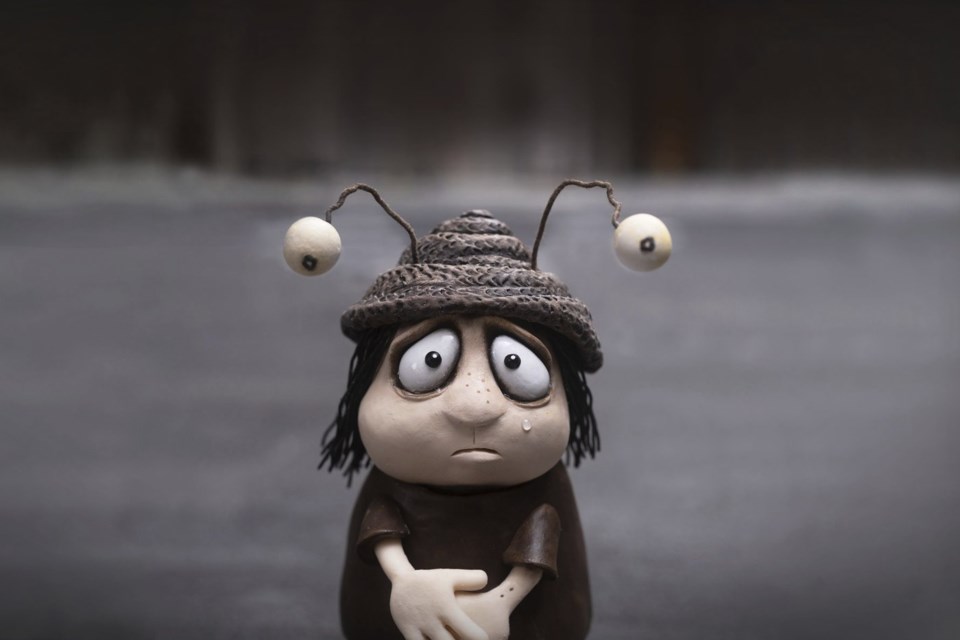ItŌĆÖs not your typical stop-motion film when characters name pets after Sylvia Plath and read ŌĆ£The Diary of Anne FrankŌĆØ ŌĆö or when the story's inspired by a quote from existentialist thinker S├Ėren Kierkegaard.
And itŌĆÖs certainly not your typical stop-motion film when you find yourself crying as much as the characters do ŌĆö in their case, with huge droplets leaking from bulging, egg-shaped eyes so authentic-looking, you expect the screen to get wet.
But those are just a few of the unique things about Adam ElliotŌĆÖs a film thatŌĆÖs as heart-tugging as it is technically impressive, a work of both emotional resonance and great physical detail using only clay, wire, paper and paint.
One thing Elliot's film is not, though, is for kids. So please take note before heading to the multiplex with family in tow: this film earns its R rating, as youŌĆÖll discover as soon as young Grace, voiced by Sarah Snook, tells us she thought masturbation was about chewing your food properly. Sex, nudity, drunk driving, a fat fetish ŌĆö like we said, itŌĆÖs R-rated for a reason.
But letŌĆÖs start at the beginning. In this, his seventh ŌĆ£clayographyŌĆØ (for ŌĆ£clayŌĆØ and ŌĆ£biographyŌĆØ), the Australian writer-director explores the process of collecting unnecessary objects. Otherwise known as hoarding, itŌĆÖs something that weighs us down in ways we canŌĆÖt see, for all the clutter. Elliot also argues that it helps us build constrictive shells around ourselves ŌĆö like snail shells, perhaps.
Our protagonist is Grace Pudel, voiced with a quirky warmth and plenty of empathy by the wonderfully agile Snook. We first encounter Grace as a grown woman, telling her long, lonely life story to her pet garden snail, Sylvia (named after Plath), at a moment of deep sadness.
Then we flash back to childhood. Grace is born with a twin brother, Gilbert (Kodi Smit-McPhee). Their mother dies in childbirth, leaving the twins with their father, a film animator. Grace needs surgery to correct a cleft palate, and doctors ask young Gilbert to donate blood; he thinks that means he'll have to die to let her live, and still says yes. (Those tears we mentioned? They start here.)
The two siblings endure a sad life with their father, a life that becomes sadder yet when a collision with a drunk driver renders him a paraplegic. It wonŌĆÖt be long before their father dies in his sleep, making them orphans. And nobody wants a full set of twins, so Grace and Gilbert are forcibly separated and sent to opposite sides of Australia.
Grace is sent to Canberra, a city so boring and safe that people drive cars with helmets on. And Gilbert is sent to a farm, with a cruel family of evangelists. The two exchange letters and pray they'll meet again. Grace's parents are swingers (this is the ŌĆÖ70s), and they end up leaving her for a nudist colony. Her only companions are her snails, which she loves, just like her mother did ŌĆö both the live and ornamental versions.
Pinky comes along five years later. The elderly woman ŌĆö raspily voiced by longtime Australian star Jacki Weaver ŌĆō has quite the past. She lost her finger dancing on a bar in Barcelona. She played ping pong with Fidel Castro. SheŌĆÖs outlived two husbands. Her friendship eases GraceŌĆÖs sadness.
But still, there's a deep hole where brother Gilbert should be. Grace adds kleptomania to her ŌĆ£list of hobbies.ŌĆØ She also starts hoarding in earnest. Finally, she meets Ken, a microwave repairman. She believes she has found love.
Life has more cruel twists in store, though, and you wonŌĆÖt see them coming in this cleverly constructed ŌĆö though unabashedly odd ŌĆö screenplay. But Elliot served here not only as writer-director but as production designer, and his biggest achievement is a rich visual world dominated by varying shades of brown, and populated by 7,000 handmade objects. Some 135,000 photographs taken on 200 sets were used to create the film.
Yet all that technical prowess would be rather useless without the emotional core that resonates throughout. Elliot has given wise Pinky, in her huge red spectacles, the aforementioned Kierkegaard line (with only the slightest edit): ŌĆ£Life can only be understood backwards, but weŌĆÖve got to live it forwards,ŌĆØ she tells Grace. And snails, she adds, never go backwards. Nor should Grace ŌĆö and nor should we.
Who would have thought an R-rated stop-motion film about mollusks could pack such a universal lesson?
ŌĆ£Memoir of a Snail,ŌĆØ a IFC Films release, has been rated R by the Motion Picture Association ŌĆ£for sexual content, nudity and some violent content. ŌĆ£ Running time: 94 minutes. Three stars out of four.
Jocelyn Noveck, The Associated Press



